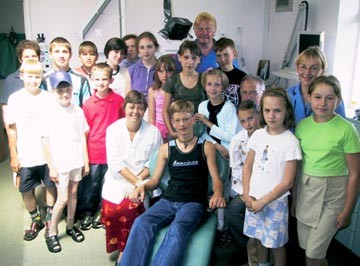
Chernobyl children arrive for dental treatment
- Select a language for the TTS:
- UK English Female
- UK English Male
- US English Female
- US English Male
- Australian Female
- Australian Male
- Language selected: (auto detect) - EN
Play all audios:

Chesterfield Primary Care Trust (PCT) has been playing host to a group of children from the radiation-affected country of Belarus. The children were given dental check-ups by the PCT's
Community Dental Service at Saltergate Health Centre. Many children from Belarus visit the United Kingdom each year, as a result of the work of Chernobyl Children Lifeline, a national
charity that links with rural Belarussian communities. The charity gives the poorly children a chance to live in a 'clean' environment and eat uncontaminated foods for a month.
Children visiting north Derbyshire receive support from a variety of sectors in the community. For the past three years, dental care has been provided jointly by general dental practitioners
and the Community Dental Service. Children also receive other health care, including eye tests. Belarus received 70 per cent of the radioactive fallout from the Chernobyl nuclear explosion
in April 1986 and as a result, tens of thousands of children are now being born every year with thyroid cancer, bone cancer and leukaemia. Only five per cent of children in the Chernobyl
region are left healthy. To bring child victims of the Chernobyl disaster to the UK for recuperative breaks of one month costs £250, money which initially comes from the charity but is then
continued by families who pay for children to return each year; over 21,000 have been to stay with host families since 1992. RIGHTS AND PERMISSIONS Reprints and permissions ABOUT THIS
ARTICLE CITE THIS ARTICLE Chernobyl children arrive for dental treatment. _Br Dent J_ 195, 234 (2003). https://doi.org/10.1038/sj.bdj.4810573 Download citation * Published: 13 September 2003
* Issue Date: 13 September 2003 * DOI: https://doi.org/10.1038/sj.bdj.4810573 SHARE THIS ARTICLE Anyone you share the following link with will be able to read this content: Get shareable
link Sorry, a shareable link is not currently available for this article. Copy to clipboard Provided by the Springer Nature SharedIt content-sharing initiative
